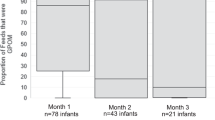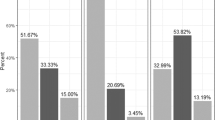Abstract
Objective:
To determine the prevalence of oral feeding problems in neonatal intensive care unit (NICU) graduates at 1 to 2 years, and to identify clinical risk factors during NICU admission.
Study Design:
Observational cohort study of 378 children, who received level III/IV NICU care for 4 days or more in 2011 to 2012, chromosomal abnormalities excluded. We detected feeding problems in four gestational age (GA) groups (<28, 28 to 31, 32 to 36 weeks, and term-borns) using the Dutch standardized Screeningslijst Eetgedrag Peuters, and collected clinical factors for logistic regression analyses.
Results:
The prevalence of feeding problems was higher in NICU (20.4%) than in reference (15.0%) population (P=0.024), but similar for all GA groups (P=0.468). Prolonged tube feeding, that is, >30 days (odds ratio (OR) 2.50, confidence interval (CI) 1.13 to 5.56) and being born small for GA (OR 4.79, CI 1.64 to 14.03) were the most prevalent risk factors in children with GA ⩾32 and GA <32 weeks, respectively.
Conclusion:
Feeding problems are more prevalent in NICU graduates, with prolonged tube feeding as most important risk factor.
This is a preview of subscription content, access via your institution
Access options
Subscribe to this journal
Receive 12 print issues and online access
$259.00 per year
only $21.58 per issue
Buy this article
- Purchase on Springer Link
- Instant access to full article PDF
Prices may be subject to local taxes which are calculated during checkout


Similar content being viewed by others
References
da Costa SP, van der Schans CP, Boelema SR, van der Meij E, Boerman MA, Bos AF . Sucking patterns in fullterm infants between birth and 10 weeks of age. Infant Behav Dev 2010; 33 (1): 61–67.
Sakalidis VS, Kent JC, Garbin CP, Hepworth AR, Hartmann PE, Geddes DT . Longitudinal changes in suck-swallow-breathe, oxygen saturation, and heart rate patterns in term breastfeeding infants. J Hum Lact 2013; 29 (2): 236–245.
Lau C, Alagugurusamy R, Schanler RJ, Smith EO, Shulman RJ . Characterization of the developmental stages of sucking in preterm infants during bottle feeding. Acta Paediatr 2000; 89 (7): 846–852.
Carruth BR, Skinner JD . Feeding behaviors and other motor development in healthy children (2-24 months). J Am Coll Nutr 2002; 21 (2): 88–96.
Gahagan S . Development of eating behavior: biology and context. J Dev Behav Pediatr 2012; 33 (3): 261–271.
van Dijk M, Hunnius S, van Geert P . The dynamics of feeding during the introduction to solid food. Infant Behav Dev 2012; 35 (2): 226–239.
Pearcey SM, De castro JM . Food intake and meal patterns of one year old infants. Appetite 1997; 29 (2): 201–212.
Rommel N, De Meyer AM, Feenstra L, Veereman-Wauters G . The complexity of feeding problems in 700 infants and young children presenting to a tertiary care institution. J Pediatr Gastroenterol Nutr 2003; 37 (1): 75–84.
Blaymore Bier J, Ferguson A, Cho C, Oh W, Vohr BR . The oral motor development of low-birth-weight infants who underwent orotracheal intubation during the neonatal period. Am J Dis Child 1993; 147 (8): 858–862.
Burklow KA, McGrath AM, Valerius KS, Rudolph C . Relationship between feeding difficulties, medical complexity, and gestational age. Nutr Clin Pract 2002; 17 (6): 373–378.
Miller CK . Updates on pediatric feeding and swallowing problems. Curr Opin Otolaryngol Head Neck Surg 2009; 17 (3): 194–199.
Wood NS, Costeloe K, Gibson AT, Hennessy EM, Marlow N, Wilkinson AR et al. The EPICure study: growth and associated problems in children born at 25 weeks of gestational age or less. Arch Dis Child Fetal Neonatal Ed 2003; 88 (6): F492–F500.
Crapnell T, Rogers C, Neil J, Inder T, Woodward L, Pineda R . Factors associated with feeding difficulties in the very preterm infant. Acta Paediatr 2013; 102 (12): e539–e545.
Burklow KA, Phelps AN, Schultz JR, McConnell K, Rudolph C . Classifying complex pediatric feeding disorders. J Pediatr Gastroenterol Nutr 1998; 27 (2): 143–147.
Crapnell TL, Woodward LJ, Rogers CE, Inder TE, Pineda RG . Neurodevelopmental profile, growth, and psychosocial environment of preterm infants with difficult feeding behavior at age 2 years. J Pediatr 2015; 167 (6): 1347–1353.
Thoyre SM . Feeding outcomes of extremely premature infants after neonatal care. J Obstet Gynecol Neonatal Nurs 2007; 36 (4):366–375.
Field D, Garland M, Williams K . Correlates of specific childhood feeding problems. J Paediatr Child Health 2003; 39 (4): 299–304.
Ross ES, Browne JV . Developmental progression of feeding skills: an approach to supporting feeding in preterm infants. Semin Neonatol 2002; 7 (6): 469–475.
Ramsay M, Martel C, Porporino M, Zygmuntowicz C . The Montreal Children's Hospital Feeding Scale: a brief bilingual screening tool for identifying feeding problems. Paediatr Child Health 2011; 16 (3): 147–151.
van Dijk M, Timmerman ME, Martel C, Ramsay M . Towards the development of a dutch screening instrument for the detection of feeding problems in young children. Netherlands J Psychol 2011; 66 (1): 112–119.
Dodrill P, McMahon S, Ward E, Weir K, Donovan T, Riddle B . Long-term oral sensitivity and feeding skills of low-risk pre-term infants. Early Hum Dev 2004; 76 (1): 23–37.
Marino A, Assin E, Carbone M, Hiatt I, Hegyi T, Graff M . The incidence of gastroesophageal reflux in preterm infants. J Perinatol 1995; 15 (5): 169–171.
Mathisen B, Worrall L, Masel J, Wall C, Shepherd RW . Feeding problems in infants with gastro-oesophageal reflux disease: a controlled study. J Paediatr Child Health 1999; 35 (2): 163–169.
da Costa SP, van der Schans CP, Zweens MJ, Boelema SR, van der Meij E, Boerman MA et al. The development of sucking patterns in preterm, small-for-gestational age infants. J Pediatr 2010; 157 (4): 603–609.
Jonsson M, van Doorn J, van den Berg J . Parents' perceptions of eating skills of pre-term vs full-term infants from birth to 3 years. Int J Speech Lang Pathol 2013; 15 (6): 604–612.
Kloosterman G . On intrauterine growth, the significance of prenatal care. Int J Gynaecol Obstet 1970; 8: 895–912.
Author information
Authors and Affiliations
Corresponding author
Ethics declarations
Competing interests
The authors declare no conflict of interest.
Rights and permissions
About this article
Cite this article
Hoogewerf, M., ter Horst, H., Groen, H. et al. The prevalence of feeding problems in children formerly treated in a neonatal intensive care unit. J Perinatol 37, 578–584 (2017). https://doi.org/10.1038/jp.2016.256
Received:
Revised:
Accepted:
Published:
Issue Date:
DOI: https://doi.org/10.1038/jp.2016.256
This article is cited by
-
Comparison of the effect of two methods of sucking on pacifier and mother's finger on oral feeding behavior in preterm infants: a randomized clinical trial
BMC Pediatrics (2022)
-
Prevalence of problematic feeding in young children born prematurely: a meta-analysis
BMC Pediatrics (2021)
-
Preterm infant feeding performance at term equivalent age differs from that of full-term infants
Journal of Perinatology (2020)
-
Prematurity and Maladaptive Mealtime Dynamics: the Roles of Maternal Emotional Distress, Eating-Related Cognitions, and Mind-Mindedness
Journal of Abnormal Child Psychology (2020)
-
Tube feeding outcomes of infants in a Level IV NICU
Journal of Perinatology (2019)



